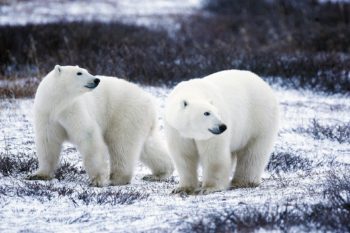
During the Pliocene, or from about 3 to 5 million years ago, subarctic regions of the Northern Hemisphere (Norway, Iceland, Canada) were up to 10°C warmer than they are now, and the Arctic region itself was as much as 19°C warmer than now, with sea-ice-free summers and no permafrost.
All this warmth occurred while CO2 concentrations were well below today’s levels. Polar bears somehow managed to survive in these balmy Arctic and subarctic climates.
“Pollen from three subarctic sites in the Norwegian Sea, northern Iceland and Labrador Sea indicate that mid-Pliocene January temperatures in Norway, Iceland and southeastern Canada were 4 to 10°C warmer than today (Willard 1994). … Evidence of both mixed deciduous/coniferous and coniferous forests places mean July temperatures 10°C warmer than today [in Arctic Canada] (Vincent 1990). In addition, northwestern Alaska air and sea temperatures during peak Pliocene interglacials were considerably warmer than present, by 7 to 8°C, with no permafrost, and absent or severely limited sea ice (Carter et al. 1986; Kaufman and Brigham-Grette 1993).”
From the press release, Robinson states that Arctic summer sea surface temperatures were about 10-18°C (50 – 64°F) on average 4 million years ago, compared to 0°C (and lower) during summers today.
“The U.S. Geological Survey found that summer sea-surface temperatures in the Arctic were between 10 to 18°C (50 to 64°F) during the mid-Pliocene, while current temperatures are around or below 0°C (32°F).”
“The consensus among these proxies suggests that Arctic temperatures were ~19 °C warmer during the Pliocene than at present, while atmospheric CO2 concentrations were ~390 ppmv.”
“Pliocene Arctic Ocean summer SSTs were appreciably warmer than modern and seasonally sea-ice free conditions existed in some regions. … At Lake El’gygytgyn (Lake ”E”) in Siberia summer temperatures were 8°C warmer than modern and at Ellesmere Island, Canada, summer and MAT [mean annual temperatures] were 11.8°C and 18.3°C higher than today.”
“[A] seasonally ice-free marginal and central Arctic Ocean was common … regionally during the early Holocene [6,000 to 10,000 years ago]. … Some species thought to be dependent on summer sea ice (e.g., polar bears) survived through these periods.”
Arctic Also Much Warmer A Few Thousand Years Ago, With Sea-Ice-Free Summers
Although far less pronounced, the Arctic climate was also much warmer than now (by 2° to 3°C) throughout significant portions of the last 10,000 years, warm enough to elicit sea-ice-free summers (or far less sea ice than exists presently). Somehow, polar bears survived during these warmer climates.
















